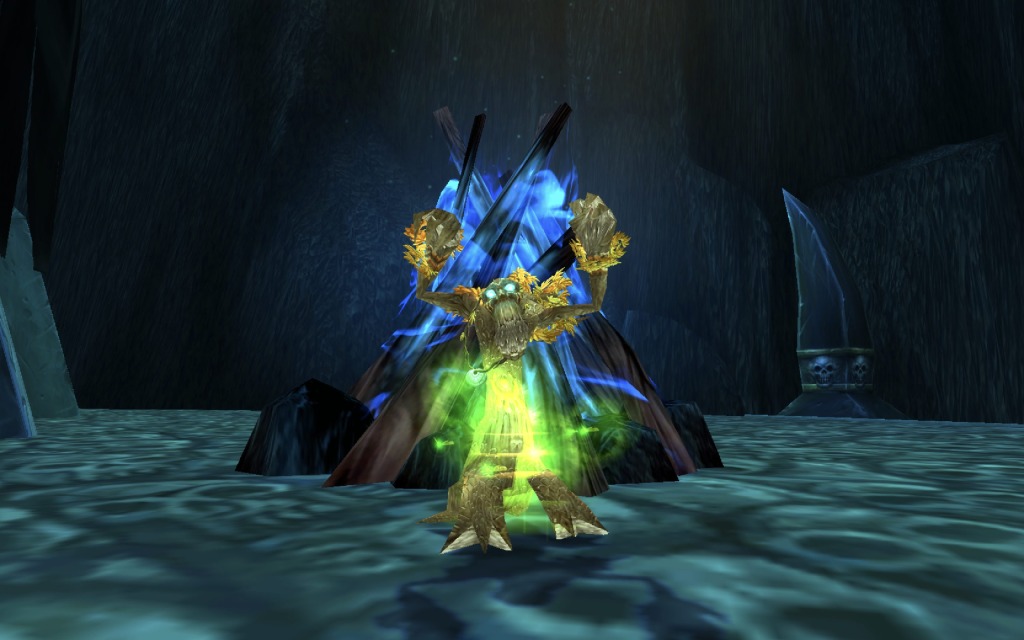- Author: Nevermore
- Date: September 27, 2022
- Updated: September 27, 2022
- Expansion: WotLK Classic
It would be hard to specify a specific, static rotation for a Restoration Druid, as the spells you will cast will be based on what your allies require in that very specific moment. This means that, instead of a rotation, we will have a priority list of spells that changes based on your situation.
Restoration Druid is a specialization based on “Heal-over-Time” effects, meaning that most of your gameplay will revolve around HoT upkeep. It’s important to mention that your abilities are subjected to a multitude of effects, such as talents, glyphs, and item set bonuses.
Our spell priority has nothing to do with your talents (we will have the default 3.3.5 talents) — instead, it all comes down to the tier set bonuses we get. Some abilities will be stronger than others depending on the phase of the expansion.
Rotations: Quick Overview
We will go over the changes to your spell priority under the “In-Depth Explanation” section in the Overview of Abilities Tab below, explaining what each tier set bonus does to your abilities and how you can better optimize your build around these.
Single-Target (Tanks)
- Place 3 stacks of Lifebloom on your main tank before the combat begins.
- Cast Wild Growth whenever available.
- Maintain Rejuvenation on all active tanks.
- Maintain Regrowth on all active tanks.
- Keep 3 stacks of Lifebloom on any tanks in need of the extra healing.
- Cast Swiftmend while moving or if you need to provide significant healing fast (Glyph of Swiftmend is mandatory!).
- Cast Nature’s Swiftness + Healing Touch in case of emergencies.
- Top health with Nourish whenever needed.
Area-of-Effect (Raid-wide/Party-wide)
- Cast Wild Growth whenever available.
- Cast Rejuvenation on every player that takes damage, or players that can benefit from Revitalize. Do not refresh it unless the effect expires.
- Use Lifebloom together with Clearcasting procs on targets taking constant damage, such as tanks. Do not stack Lifebloom on multiple targets as it will dampen your mana reserves fast!
- Cast Regrowth after you have applied Rejuvenation.
- Cast Swiftmend while moving or if you need to provide significant healing fast (Glyph of Swiftmend is mandatory!).
- Cast Nature’s Swiftness + Healing Touch as a panic button.
- Use Nourish if both Regrowth and Rejuvenation are active on the target and if they require additional instant healing.
We highly recommend that you take a look at the tabs below for in-depth discussion of the Abilities (which includes tier set bonuses changes), as well as the ability priority for Single-Target and Area-of-Effect rotations.
Abilities Overview
In-Depth Explanation
Now that we have gone through an overview of the abilities, we will talk in-depth about the single-target rotation and gameplay elements. Restoration Druids have more of a priority list of spells that they have to upkeep on a target rather than a standard rotation.
Apart from the HoT spells that Druids have to upkeep, we carry 2 different filler spells that provide direct healing, one of them providing a heal-over-time effect as well.
HoT Spells
Important Note: you should never refresh your HoTs before their duration expires! This way you will allow the spells to reach their full extent and help yourself manage your mana! If you refresh your HoTs before their duration is finished, you simply end up wasting your mana.
- Rejuvenation is our most powerful spell, affected by different effects throughout the entire expansion. Those effects range from the ability to critically strike (through Tier 9 set bonus), to the ability to be affected by haste (through Glyph of Rapid Rejuvenation), to provide an additional direct healing effect (through Tier 8 set bonus), and even to have the chance to jump towards a new target (with the Tier 10 set bonus).
- Rejuvenation should always be maintained on the target at all times!
- Lifebloom can be stacked up to 3 times on a target. You should always try to maintain this on your target. However, you should stack this spell before the fight and maintain it in the moment of the engagement itself by reapplying a new stack (stack it on the tank).
- Maintaining Rejuvenation takes priority before stacking up Lifebloom. If you are stuck between the decision of adding a new stack of Lifebloom and renewing Rejuvenation, you should always choose Rejuvenation.
- Wild Growth is another HoT spell that you should maintain at all times! The benefit of Wild Growth is that it offers a fast ramping-up spell, that slows down as it reaches its end, providing fast healing. Wild Growth also affects targets in proximity to the target, offering an area-of-effect healing besides the single target.
- Wild Growth can be placed immediately after Rejuvenation, and it’s usually best to place right after the pre-stacking of Lifebloom (stack it on the tank).
- Regrowth can be considered both a direct healing spell and a Heal-over-Time spell. Regrowth should be maintained on the target after you manage to place the rest of your Heal-over-Time effects.
Filler Spells
Now that we have talked about the priority of our HoTs, we will talk about our “Filler” spells.
There are 2 main filler spells, and one very situational direct healing spell.
- Healing Touch is your first direct healing spell. This one can’t be truly considered a filler spell, but rather a very situational direct healing spell. The only time you will want to use this is with Nature’s Swiftness to provide a last-resort healing spell that can potentially recuperate a high amount of health.
- The reason why Healing Touch cannot be considered a filler spell is due to the extreme mana cost and ridiculously high cast time.
- Regrowth is our first true “Filler” spell, and the one used the most throughout the expansion. The reason why is due to the direct healing part, but also because it offers an HoT effect as well. It combines the best of both worlds with a very accessible cast time that can further be reduced to 1 second with enough haste.
- Regrowth will be mainly used as a filler spell through Phase 2 and Phase 4.
- Nourish is our second “Filler” spell, providing direct healing, empowered by 20% if one of your Heal-over-Time effects is present on the target.
- Nourish truly flourishes during the first and third phase of Wrath of the Lich King.
- During Phase 1, the 4-set bonus of Tier 7 provides 5% increased healing for each HoT effect on the target, reaching a total of 20% increased bonus healing from the set bonus alone. If you add on the Glyph of Nourish, you will get another 24% healing increase. With all of these counted in, Nourish can reach an astounding 64% healing increase of the initial value, providing a stronger healing spell than Healing Touch.
- During Phase 3, Nourish loses the tier set bonus but can still provide amazing results due to the set 9 tier bonus of an increased 5% critical strike. Glyph of Nourish can be considered a very potent choice for Phase 3.
- Lastly, we will talk about Swiftmend! This ability has the potential to provide huge direct healing because of a chance for critical strikes. Having a 15-second cooldown, with Glyph of Swiftmend as an essential pick, this ability turns into one of the best life-saving abilities in your arsenal.
- The reason for this is that you can quickly place Rejuvenation on the target and then use Swiftmend to provide a hefty critical strike of the entire value of Rejuvenation, without consuming the HoT itself.
Single-Target Priority
The Overview of Abilities should have walked you through the one general priority list we have for the Restoration Druid, but there is also specific priority for each different phase that entirely depends on your tier set bonus, which you will find covered in this section.
Single-Target Rotation (Tanks)
- Place 3 stacks of Lifebloom on your main tank before the combat begins.
- Cast Wild Growth whenever available.
- Maintain Rejuvenation on all active tanks.
- Maintain Regrowth on all active tanks.
- Keep 3 stacks of Lifebloom on any tanks in need of the extra healing.
- Cast Swiftmend while moving or if you need to provide significant healing fast (Glyph of Swiftmend is mandatory!).
- Cast Nature’s Swiftness + Healing Touch in case of emergencies.
- Top health with Nourish whenever needed.
Area of Effect
Restoration Druids can be considered the Kings of Area-of-Effect!
However, there is still no true area-of-effect rotation for a Restoration Druid. They can achieve their AoE potential by simply placing multiple instant cast Heal-over-Time effects, some of them affecting multiple targets at once.
- Wild Growth is your main area-of-effect spell, affecting up to 5 targets. With the addition of Glyph of Wild Growth, you can affect up to 6. This spell has a low cooldown and provides quite hefty amounts of healing.
- Rejuvenation can be considered our true second area-of-effect spell, as you can simply place it instantly on each target that requires your aid.
- Tranquility is our last area-of-effect spell, affecting the Druid’s group (not the entire raid) with a powerful channeled healing spell, that ticks every 2 seconds, lasting 8 seconds in total.Tranquility is a spell that should be used in only the direst of situations, as it has a very long cooldown.
Area of Effect (Raid-wide/Party-wide)
A typical Raid-Wide Rotation will look like this:
- Cast Wild Growth whenever available.
- Cast Rejuvenation on every player that takes damage, or players that can benefit from Revitalize. Do not refresh it unless the effect expires.
- Use Lifebloom together with Clearcasting procs on targets taking constant damage, such as tanks. Do not stack Lifebloom on multiple targets as it will dampen your mana reserves fast!
- Cast Regrowth after you have applied Rejuvenation.
- Cast Swiftmend while moving or if you need to provide significant healing fast (Glyph of Swiftmend is mandatory!).
- Cast Nature’s Swiftness + Healing Touch as a panic button.
- Use Nourish if both Regrowth and Rejuvenation are active on the target and if they require additional instant healing.












Nevermore, u r awesome. Love read your guilds. Please, can u make for us a emergency macro: Nature’s Swiftness +Healing Touch .
Love u, Nevermore.
I mean macro…
To those emergency
😀
Can u make us s macro to this:
Cast Nature’s SwiftnessNature’s Swiftness + Healing TouchHealing Touch as a panic button.